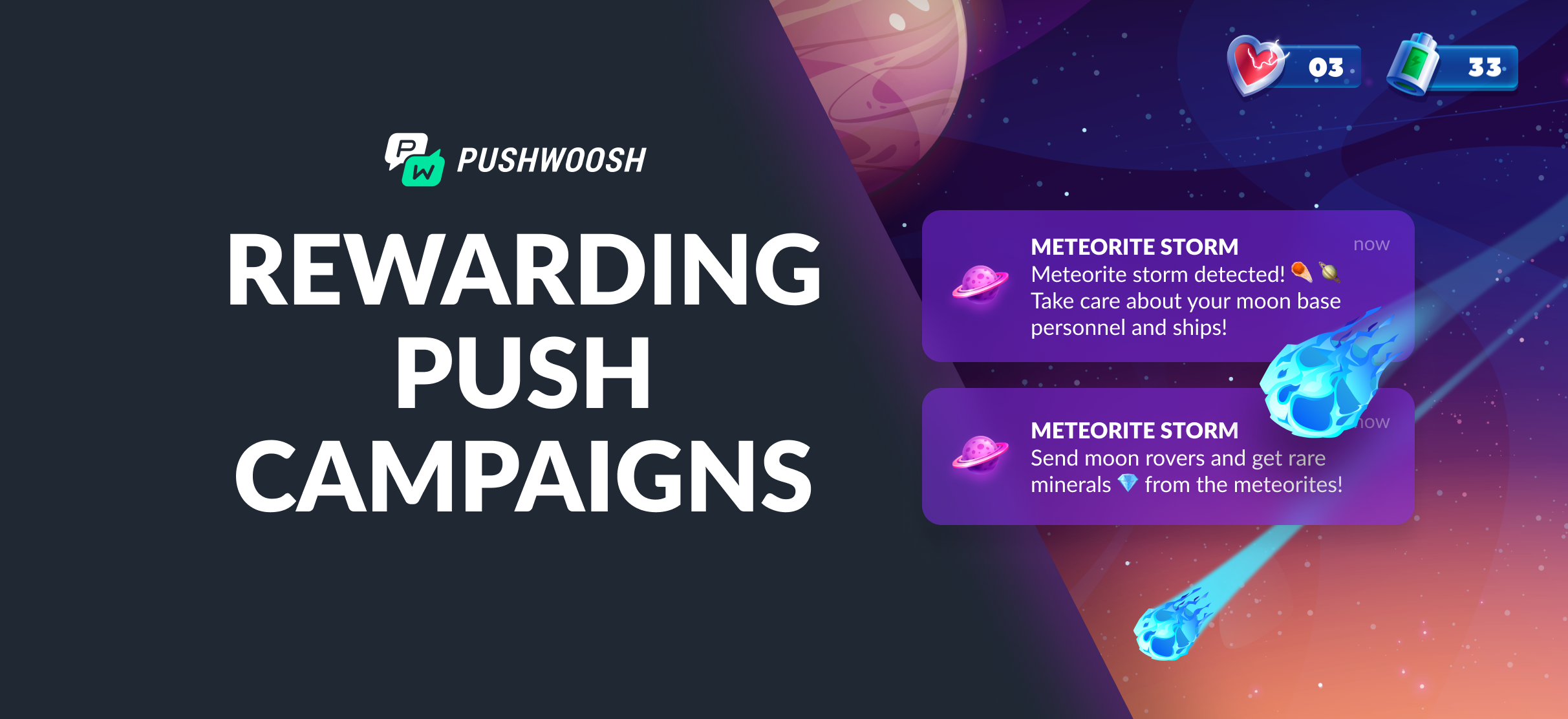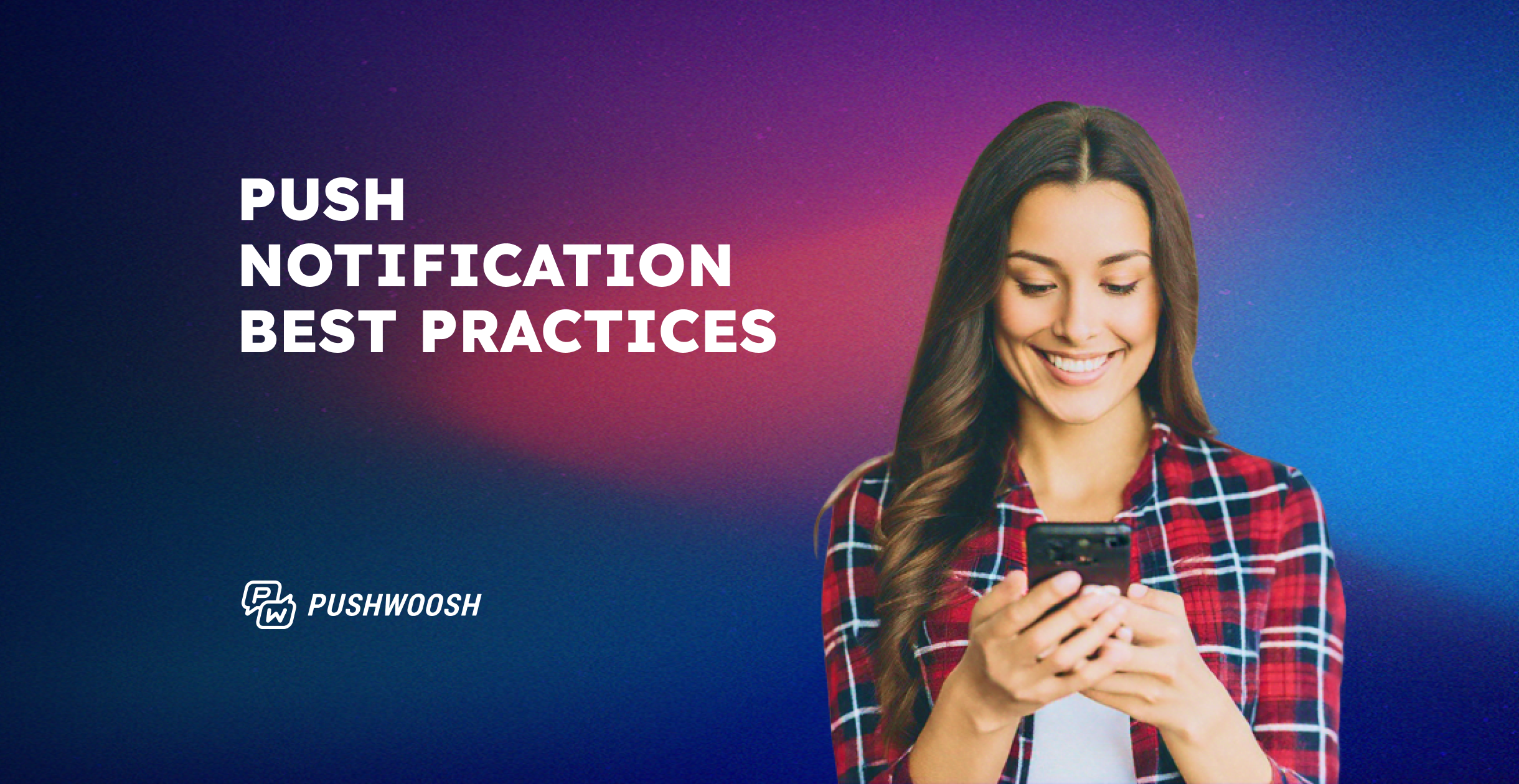How gaming apps can triple their DAU & MAU with push notifications
Your mobile game competes for the user’s attention among all the other apps on their phone. The task is to stand out from the crowd and encourage users to make playing the game a habit.
Customized game push notifications will keep your users active and maintain communication with them.
In this blog post, we will delve into three push notification campaigns for gaming apps. They incorporate strategies that have been proven to increase click-through rates, foster engagement, and ultimately boost revenue. They are designed to be easily implemented, giving you the power to take control of your game’s engagement strategy.
Market trend:
The growing challenge of acquiring and retaining players in mobile gaming apps
Strategy & Tips: • Convince players to opt-in for push notifications • Best practices for mobile game push notifications • Establish a habit of play • Transform casual players into loyal fans • Re-engage dormant players • Analyze the key performance metrics
The growing challenge of acquiring and retaining players in mobile gaming apps
The mobile gaming market experienced a 10% decrease in downloads compared to the previous year. Nevertheless, games such as Block Blast, Royal Match, Candy Crush, and Gardenscapes continued their YoY growth, as they engaged current users and practiced the ‘live operations’ approach treating the game as a service that needs ongoing improvement.
Considering that the overall effective cost per install (eCPI) increased across different genres while user retention dropped,mobile game publishers aiming for profitability should adopt a retention-focused approach, like the leaders did.
Our analysis shows that currently, most gaming apps aren’t particularly strong at user retention, as retention rates decrease all the way from Day 1 to Day 30.
At the same time, we have found a linear correlation between push engagement rates and overall retention rates. This presents an excellent chance to capitalize on the potential of push notifications, which provide a cost-efficient way to connect with existing players.
You only get one chance to convince players to opt-in for your push notifications; use it wisely
Now, both Android and iOS apps must request permission to send push notifications to their users. If they are not convinced straightaway, the app may never get a second chance to request an opt-in: before another opportunity arises, the player may uninstall the game altogether. So it’s crucial to choose the perfect moment and display persuasive copy that willencourage players to agree to receive messages.
Any tips from Google and Apple, maybe?
Both platform developers suggest requesting notification permissions after users have familiarized themselves with the game—this is favorable for the user experience.
Allow players to take a meaningful action first and then trigger an in-app message highlighting the benefits of enabling notifications. When users recognize the value of receiving notifications, the number of opt-ins willl increase.
Moreover, this approach guarantees that the system message will be activated only after verifying the user’s true interest. It also enables you to experiment with and improve the in-app message over time, boosting the chances of users consenting to push notifications even further.
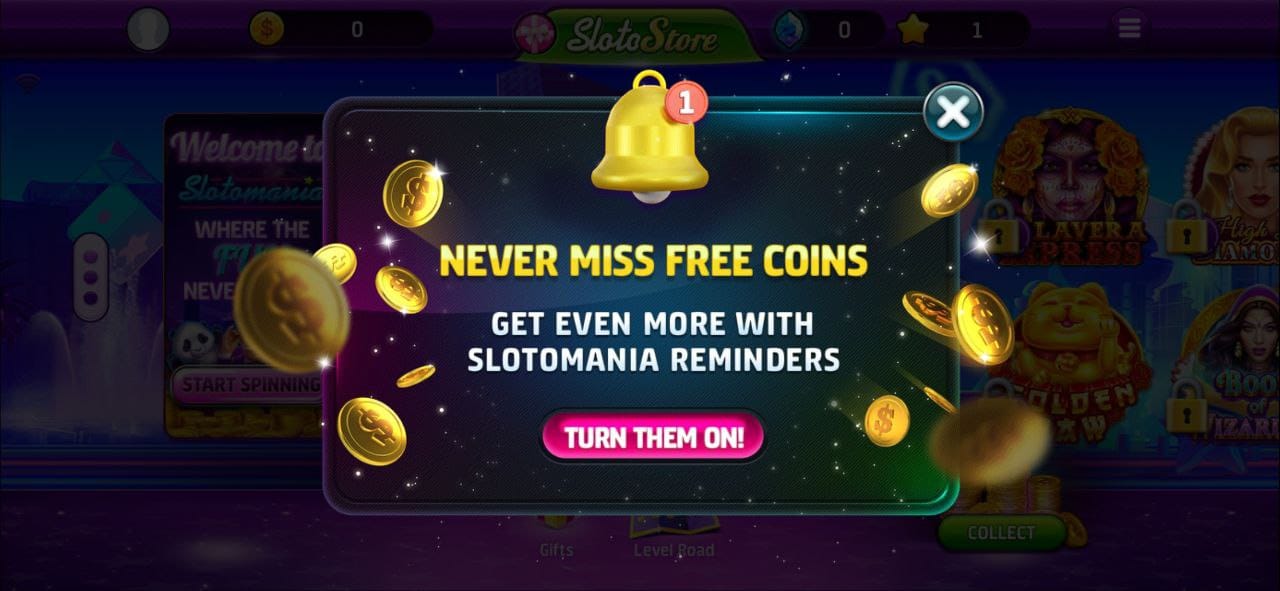
Example: push notification opt-in request in Slotomania
💡Discover how Bladestorm successfully maintained a **97%** push opt-in rate using Pushwoosh and learn how they effectively managed players who intended to unsubscribe.
Create a winning opt-in screen with Pushwoosh
With a no-code solution like Pushwoosh, you can quickly create a pre-opt-in screen and experiment with its key message.
Log in to your account, navigate to Content, and select In-Apps—there, you can choose a customizable in-app template or design your message from scratch.
Look at the in-app message we’ve designed in five minutes. No, we didn’t create it that quickly just because we know our platform 😁
Pre-opt-in screen designed with Pushwoosh
Pushwoosh has a user-friendly rich media builder that synergizes seamlessly with our AI Composer, helping you generate engaging content in mere seconds.
Take a look at the copy choices it provided for the example above. Do they sound out of tune to you? No worries. Our AI writing assistant allows you to customize the tone of voice to match your game’s style and feeling.

Pushwoosh’s AI Composer
You have crafted the ideal message, but its effectiveness remains unknown until you evaluate how it resonates with your audience. You can assess the impact of every in-app message you create, among other advanced reporting capabilities we have in Pushwoosh.
In-app message performance report in Pushwoosh
Best practices for mobile game push notifications
Great news! You’ve obtained permission to send push notifications to players. Now, it’s time to start communicating effectively. When sending out any notifications, it’s crucial to follow these three rules:
- Keep your notifications concise and informative. Providing valuable information clearly and briefly is key for push notifications. Simply input your desired keywords and let our AI Composer do the rest by generating high-quality copy that will grab your audience’s attention.
- Avoid bombarding users with multiple notifications on the same topic, even if they haven’t opened it. Using Pushwoosh, you can track whether the push notification you’ve sent was opened. This allows you to determine if you should resend the same message in a couple of days or if you should try a different message or channel for your next communication attempt.
- Be mindful of players who are actively engaged with the game. Notifications shouldn’t disrupt gameplay. For instance, if a new house is built in the game, the player can be informed about it with an in-app message rather than through a distracting notification.
Now, let’s dive into three game push notification campaigns tailored to the players’ context.
Establish a habit of play
Once players sign up and start playing, it’s essential to keep them engaged. What player will resist daily bonuses sent in the form of personalized push notifications?
🌟Thanks to personalized push notifications, our customer Beach Bum has achieved an incredible **3x growth** in DAU and MAU across all their game apps.
Beach Bum’s personalized push notifications
To grab your audience’s attention and keep them coming back for more, craft dynamic communication campaigns using Pushwoosh Customer Journey Builder.
For example:
⚡ When a player signs up, you can use it as a trigger to start your habit-building push notification campaign.
🔔 Verify their push notification reachability to ensure they receive your messages. If they are reachable via push notifications, you can send them a personalized welcome message mentioning the daily bonus they will receive by logging in daily. If they are not reachable on this channel, you can email them.
📅 The next day, send the first daily bonus push notification to those players who engaged with the welcome message. If some of the players don’t interact with the welcome push notification, try a different copy.
📲 Then, send push notifications on a daily basis to those players who interact with them. To engage with players who don’t claim their daily bonus, tweak the content or the structure of the message to see what resonates with your audience.
🔀 Include as many behavior branches as you see fit in your campaign.
The main takeaway is that you should extensively utilize the tracking data available to you and adjust communication based on user behavior. The following customer journey serves as a blueprint for a campaign that helps users develop a habit of playing your game.
Don’t underestimate the power of crafting compelling copy when preparing your notifications.
👩🦰 Personalize messages with any available variables: the player’s name, the level they’ve reached, and the remaining bonuses to claim.
🌍 Also, if you know that a segment of your players speaks Spanish, for example, address them in the language of their heart to turn them into loyal users.
🌟Daily offers helped Bladestorn boost their DAU by an impressive 16% in just eight months with the help of Pushwoosh! Learn more in the success story.
Transform casual players into loyal fans
Let’s consider a group of players who claimed the daily bonus for five consecutive days. These players could be identified as potential brand loyalists with Pushwoosh’s RFM segmentation tool or our integrated partners such as AppsFlyer, Adjust, Mixpanel, or Amplitude.
You can start a campaign aimed at converting these active players into paying customers.
Conduct an A/B/n test to determine which push notification variation persuades players to make an in-app purchase.
For demonstration purposes, we’ll look at branch A of the journey below.
🔹 If users make a purchase after the first push, they will exit the journey. If they don’t, you can send them a push notification with a 20% discount.
🔀 You can then split the segment again and invite the remaining users to participate in a special challenge, where they will need boosters to succeed.
🚀 Afterward, you can set up a dedicated campaign for the challenge participants and encourage them to buy boosters.
Feel free to repeat the same communication structure for each communication branch of the test, trying out different copy, discount %, or imagery.
After running the test for a while, review its results and deactivate lower-performing branches by selecting “Keep only winner” in the test statistics window. New users will be directed to the winning branch, while those who have already interacted with deactivated branches will continue through them until completing their journey.
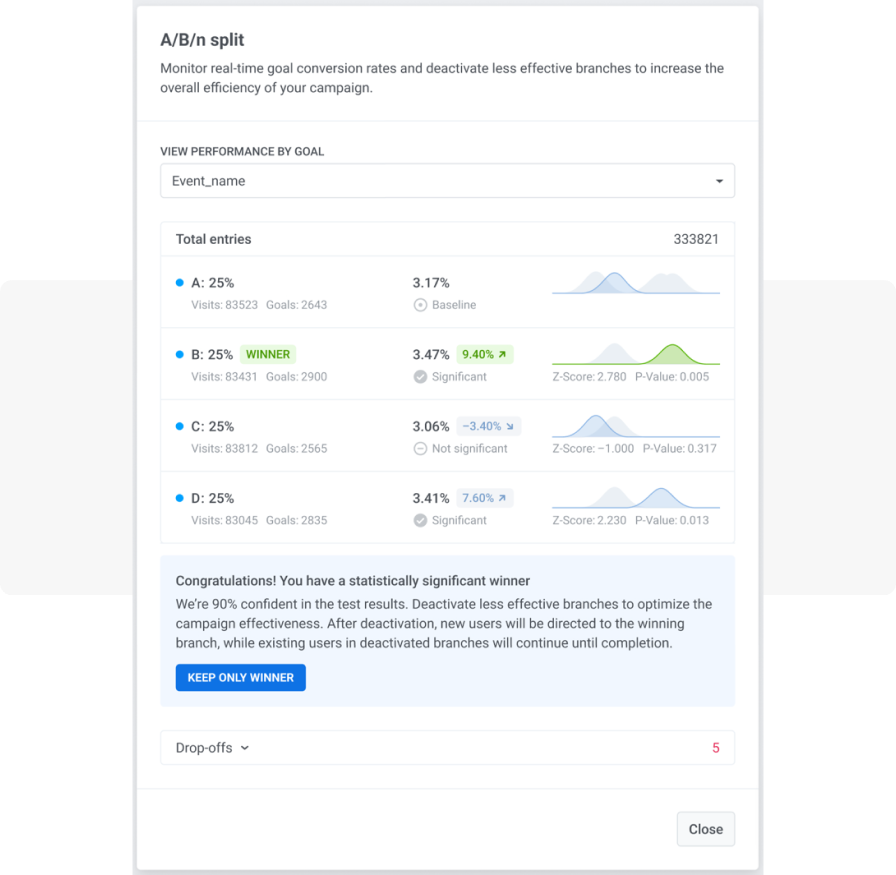 💡Learn more about field-proven mobile game monetization strategies to increase app revenue.
💡Learn more about field-proven mobile game monetization strategies to increase app revenue.
Re-engage dormant players
As a preliminary step, define what qualifies as “dormant” in your game (e.g., players who haven’t logged in for 3, 7, 14, or even 30 days). Next, look at the tags and events that provide a fuller picture of these users, such as in-game behavior, last active date, spending habits, or game level. You can use these insights later to personalize messages.
Imagine you want to nudge players who haven’t played for three days.
🧔🏾♂️Send them a personalized push message incorporating the player’s name, last achieved milestone, or specific challenges they participated in.
⏳Create a sense of urgency with time-sensitive deals or events to motivate them to return to the game.
🤩 Emojis, images, or GIFs will make the notification more visually appealing. See for yourself!
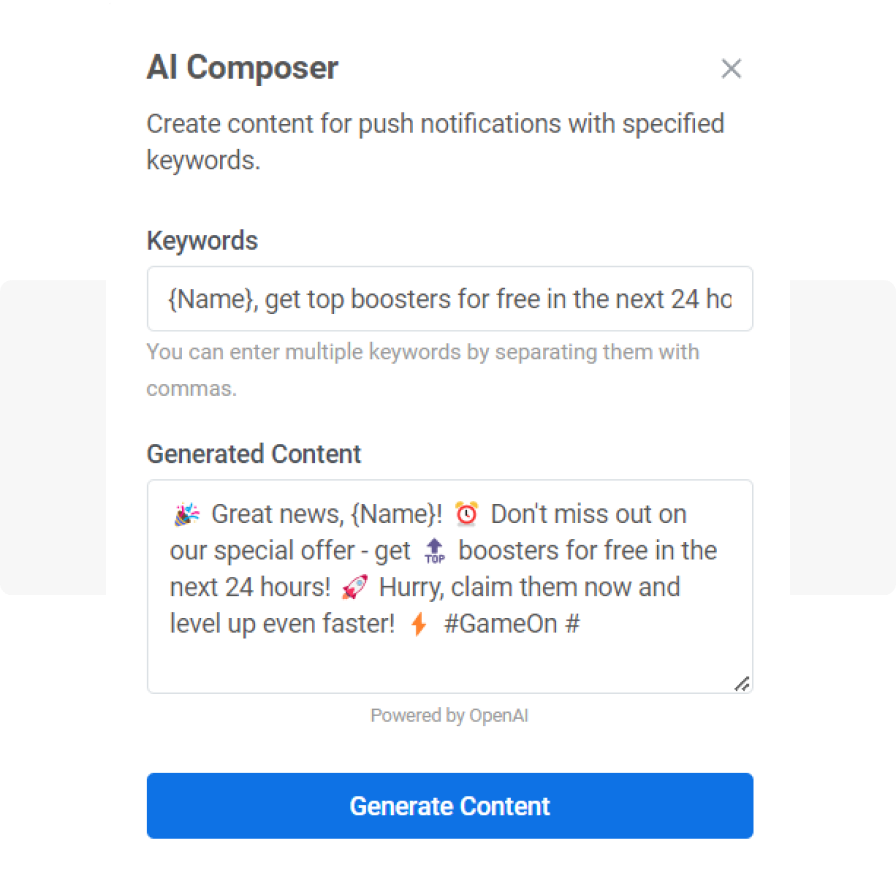
Send the first push message with an offer that expires in 24 hours. Next, you can split the journey based on whether players open your message. In case players do not interact with the message within 12 hours, send them a reminder saying that their offer is about to expire.
If they engage in the game, they can exit the journey. If not, you can add a three-day time delay to this customer journey and send them a brief notification asking for feedback. This strategy will enable you to gain insights into your players’ preferences and thoughts.
By following this campaign structure, you can effectively re-engage dormant players, bringing them back into the game and enhancing their overall gaming experience.
Analyze the key performance metrics on personalized reporting dashboards
After putting in an extensive effort to achieve game-changing results, you may crave to see them visualized in a dedicated reporting dashboard.
Pushwoosh anticipates your needs and provides you with comprehensive tracking and in-depth analysis of key metrics, including recipients, click-through rates, sends, deliveries, opens, application installs, and uninstalls. This provides invaluable insights into your campaign’s performance.
Moreover, you can tailor the dashboard to focus on the most valuable metrics for your gaming app.

Push notifications reporting dashboard in Pushwoosh
Get ‘overpowered’ at push notifications with Pushwoosh
Push notifications provide a timeless way to increase user engagement and grow your gaming app. By using well-crafted push notification campaigns, you can effectively grab and keep users’ attention, building a stronger connection with your game.
Implementing tactics such as offering personalized daily bonuses, sending targeted messages to potential loyal customers, and re-engaging dormant players can significantly increase your active user base. The success stories of apps like Bladestorm and Beach Bum highlight the potential for achieving triple growth in DAU and MAU.
With Pushwoosh’s user-friendly tools, you can create compelling, personalized push notifications that resonate with your audience in a cost-effective way—you’ll see it at a glance at our detailed reporting dashboards.
Are you ready to make your game a hit? Get started with Pushwoosh now for free!










